Engineering Technology and Construction Management
Engineering technology studies were a significant part of the UNC Charlotte College of Engineering from its very beginning. In the early days of Charlotte College, technology courses led to associates degrees and could be transferred to engineering and technology programs at other universities. UNC Charlotte started its own bachelors programs in engineering technology in 1970. The programs grew steadily at times and dramatically at others, going from 22 students in 1970 to 675 in 2014. Major milestones in the programs included the addition of fire safety in 1999, lower-division courses in 2004, construction management in 2007, and three master’s degree programs in the 2010s.
The first faculty member in engineering technology was Carter Grant, who came to UNC Charlotte in 1969 to get the ET programs started. He had a busy first year, hiring one faculty member in each ET discipline. They were Cheng Liu did Civil ET, Ron Priebe in Mechanical ET, and George Elliott in Electrical ET. This first team of ET faculty began teaching classes in 1970. The bachelor’s degree programs were exclusively 2+2 courses of study, with students having already completed their associates’ degrees at a community colleges before coming to UNC Charlotte for their bachelor’s degrees.

Originally from Taiwan, Cheng Liu had a Master’s of Civil Engineering from West Virginia University and had been working as a soils engineering in industry before coming to UNC Charlotte. An expert in the discipline of soils, Liu started the soils laboratory in the Smith Building when he arrived. During the course of his career, he was also a principal author, along with Jack Evett of UNC Charlotte Civil Engineering, on two soils textbooks, “Soils and Foundation” and “Soil Properties – Testing, Measurement and Evaluations.”
Liu became chair of the Engineering Technology Department in 1996 and served in that capacity until 2002. During his tenure as chair, the department started the Fire Safety ET program, began a distance learning program in electrical and won the Provost Excellence in Teaching Award.
“The Engineering Technology Department had its beginning in 1969,” Liu said. “Carter Grant was hired to start the program, and at the time he was the chairman and the only faculty member. The first program was actually electronics and computer technology, leading to a Bachelor’s in ET (BET) degree. It had about 22 students to start.”
With the first faculty members hired in civil and mechanical engineering technology and an additional person in electrical, the programs began to grow steadily. The first graduates were from electrical engineering technology in 1971, followed by graduates from civil and mechanical in 1972. Shortly after graduating their first students, the programs applied for their first nationally recognized accreditation.
Prior to beginning his more than 46 year career at UNC Charlotte, Ron Priebe worked in the aerospace industry at locations in Illinois, California and Colorado. His area of expertise was high-pressure hydraulics. His decision to leave industry for academia in 1970 was founded in a desire to try something different.
“This was something new, something rather exciting,” Priebe said. “It was a different opportunity and a different atmosphere.”
As the only mechanical engineering technology instructor for the 12 MET students enrolled during his first year at UNC Charlotte, Priebe had an all-inclusive teaching load. Helped did arrive the next year, when a second MET person came on board.
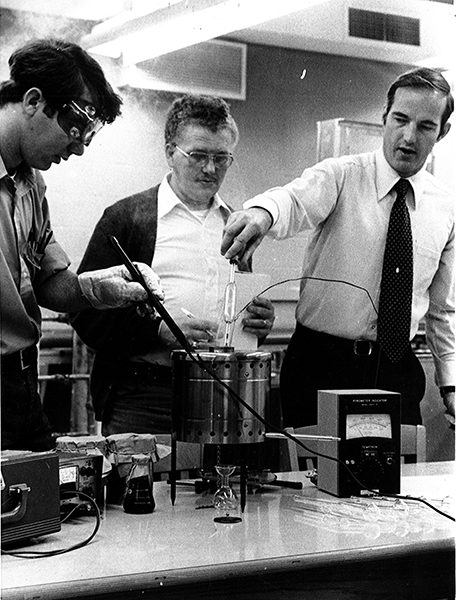
“We taught everything in the program that was to be taught,” Priebe said. “We had nothing, not a text book, not a note, not a laboratory experiment. It was a lot of long hours. I worked 8 to 5 here, then at home from 7 to 11 pretty regularly.”
The first years did come with growing pains. “We hadn’t done it before,” Priebe said, “and there were a lot of mistakes, starts and stops. It got better over the years; I think appreciably better.”
There were a number of department chairs during the first years. Following Carter Grant was Richard Phelps, and then a steady rotation of others.
“We had a number of chairmen,” Priebe said. “Ed Willis was one, a retired military colonel was one, Bill Shelnutt was one, I myself chaired the department a couple years, and there were a few others. Then there was Ed Braun, Cheng Liu and Tony Brizendine. The position of chair used to rotate. There wasn’t any formal plan or length of term. Someone would just do it until they got tired of doing it. It was almost an ‘I’ll volunteer to do it for two or three years and then it will be someone else’s turn,’ sort of thing.”
The small ET Department within the fairly small College of Engineering had a very collegial atmosphere, Priebe said. “We were in the same building and we saw each other daily. You could stop by somebody’s office to talk to them, or walk by a lab where they were working to find out what they were doing. We also had faculty meetings and made some decisions that were really significant. For example, the first degrees offered were BET degrees, bachelors of engineering technology, without the science. The faculty fought to change it to what it is now, the BSET degree, Bachelor of Science in Engineering Technology.”
The students also played a significant role in changing the BET to the BSET. To make their desires for the degree change more visible, they wrote “BSET” in chalk on the transoms above all the office and classroom doors of the engineering technology in the Smith Building.
“We had a group of very active students at the time who pushed that very hard,” Priebe said. “I strongly expect that’s really the reason the change was made at that time. We thought we had enough in the curriculum for a BS, and when we investigated we found out, sure enough, we do have enough physics, chemistry, math and science hours in there to be classified as a science degree. Then we went to the faculty to change it from BET to BSET. And I think it was a good move. I think it opened some doors for our graduates that might not have been open with the BET degree.”
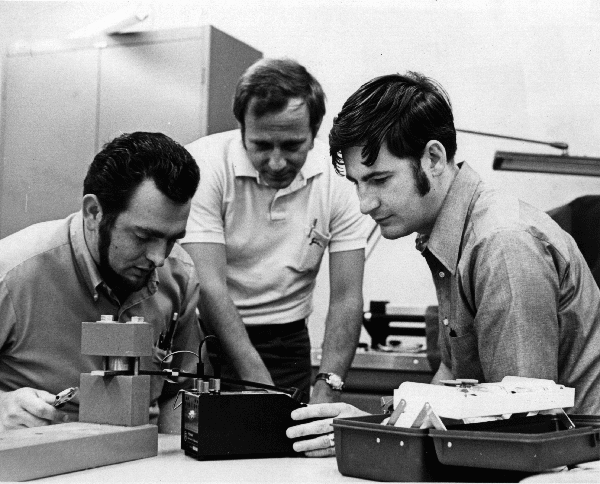
From its very beginning, the Engineering Technology Department required its faculty to have industrial experience and participate in industrial collaborations. “It was kind of routine that faculty in ET were supposed to have five years of appropriate industrial experience,” Priebe said. “Early on, the faculty typically had a lot more than five years. It was also an understanding when faculty members of my era started they would spend one day a week for consulting. That was just the accepted practice.”
Priebe himself worked as a consultant with more than 100 different companies during his career. Most were in the Charlotte area, but some were spread throughout the country.
“I found that almost anything I did on the outside somehow got back to the lectures and the laboratories,” Priebe said. “So, in addition to serving the engineering needs of the community, we were integrated real-world experiences into the classrooms.”
The biggest change to his profession and to the teaching of mechanical engineering was the advent of computers, Priebe said. “When our program got started in 1970 it was absolutely a slide-rule culture. I remember when we bought four electronic calculators. They were four-function calculators; they could add, subtract, multiply and divide. I believe we paid $550 apiece for them. It was really quite a big event. Now the fact that we have multiple computer laboratories is a huge change.”
Priebe was still teaching at UNC Charlotte in 2015 when this was written. As to why he has stayed here 46 years and counting, he said: “I enjoy the teaching, I get some joy out of that. I’m trying to add a little bit of value to something. The number of really good, quality, competent, honest people I’ve been able to work with here has been wonderful and I’ve enjoyed that. It’s been good.”
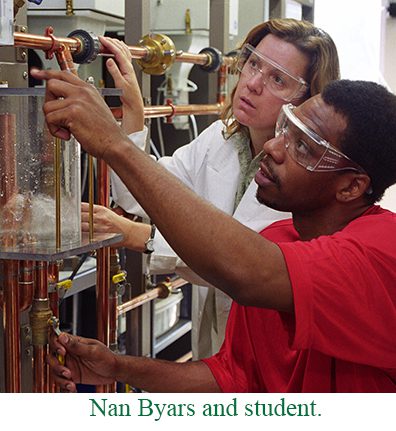
Nan Byars came to UNC Charlotte in 1993 from Cal Poly, where had been teaching. She thought Charlotte would be a good fit for her young family, and that the ET Department would be a good place to grow. The department had less than 20 total faculty members at the time, and in her field, Mechanical ET, there were six people.
“Looking back, it still amazes me that we were all shoehorned into this building (Smith),” Byars said. “Now the college has expanded into four buildings, and I think we could use some more space.”
With all of engineering in the Smith Building, cooperation between the engineering technology and engineering disciplines was essential for success. Mechanical ET and Mechanical Engineering shared labs, as did Civil ET and Civil Engineering, and Electrical ET and Electrical Engineering. “Space was tight,” Byars said, “but the up side was it made it easier to collaborate and work together. I saw those people more. You ran into each other more.”
The ET Department was essentially a small college of it owns, with multiple disciplines and programs. “It was a surprisingly cooperative atmosphere,” Byars said. “Again, the advantage was it was much easier to collaborate with other disciplines, because we were right here in the same space and we were in the same department. We shared resources, so it made collaboration easy.”
When she started at UNC Charlotte, Byars largest classes had 30 to 35 students. By 2015, that number had grown to 50.
“The ET department had explosive growth,” Byars said. “We used to teach just upper-division courses and we were exclusively a 2+2 program. Then we expanded beyond junior and senior levels when we added the freshman and sophomore years. In addition to expanding and adding the lower divisions, we also added construction management and fire safety. And all of the original programs grew, especially mechanical.”
ET added the freshman and sophomore year options to its programs in 2004. The new lower divisions provided an alternative for students interested in engineering technology and in a traditional four-year college experience. A total of 127 lower-division students enrolled in the first year of the new four-year degree programs, growing overall department enrollment 47 percent.
The timing of the new program was excellent, because in 2005 the Mechanical Engineering Department moved to the new Duke Centennial Hall, and the Civil Engineering Department moved to the Cameron Center. This provided the ET Department with much more space in the Smith Building. One of the first projects of the Mechanical ET group was to build a new machine shop lab.
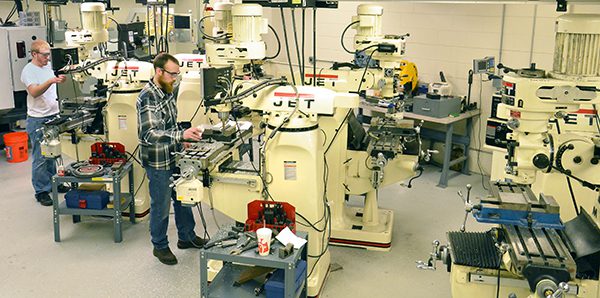
“We felt with ET it was very important go give students a good hands-on experience,” Byars said “They had to have machine shop skills if they were going to do design-build projects such as those in senior projects. They also had to know how things were made so they could design them when they went on to careers in industry.”
The addition of lower divisions did add new dynamics to the ET Department, especially when the lower-division students and 2+2 students came together in their junior years. “What was nice was we had more diversity in the classroom during the junior and senior years,” Byars said. “With the 2+2 students a number of them worked for a while before they got their associates degrees. They brought that work experience with them into the classroom. The students who came from high school were more well-rounded in fundamentals like math and science. When we brought them together they could kind of teach each other. It was always nice to have people in class who had experience and could ask good questions.”
In 2007, the Bachelor of Science in Construction Management (BSCM) program started. The program was designed to provide the education needed in the fast-growing Charlotte region for entry into the construction industry (residential, commercial, industrial sectors, infrastructure, and heavy horizontal construction) and related careers such as real estate and land development, infrastructure development, code enforcement and insurance.
The Construction Management program admitted 130 students in its first two years. As the first departmental degree program that was not in engineering technology, the addition of CM also led to changing the department name to Engineering Technology and Construction Management (ETCM).
In 2012, ETCM began its first graduate level programs. To support UNC Charlotte’s research goals, ETCM faculty were doing more and more research and they needed graduate programs to provide them with student researcher assistants. The Master of Fire Protection and Administration, and the Master of Science in Construction and Facilities Management were the first two ETCM graduate programs. They were followed in 2014 by the Master of Science in Applied Energy and Electromechanical Systems, which was renamed Applied Energy and Electromechanical Engineering in 2022.
“The graduate programs have been another transition,” Byars said. “It was kind of exciting to see the graduate students. What was super gratifying was to see students you had known since their freshman year taking that next step further. Watching those students evolve brought great pleasure. With graduate students you got to see them go that much farther.”
For the future, Byars said she would like to see the Master’s in Applied Energy and Electromechanical Systems continue to grow. In 2015, it was still a relatively new program and hadn’t met its potential yet. “We were here to respond to the needs of our constituents, and we did that with programs like construction management and fire safety,” she said. “The electromechanical masters was also created to meet a need, and I expect to see it become a substantial program that will do just that.”
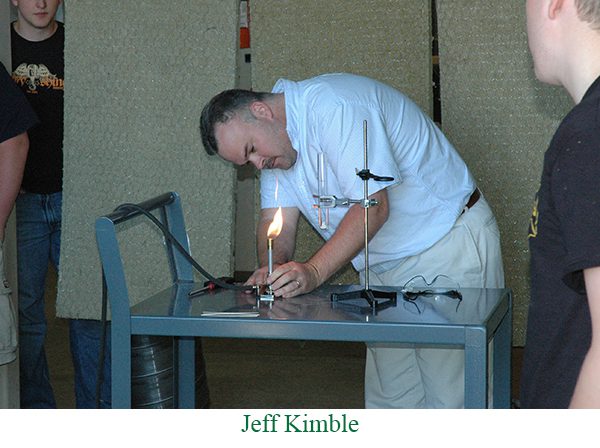
Jeff Kimble came to UNC Charlotte in 1999. His task was to start the ET Department’s Fire Safety Engineering Technology program. Kimble began his fire career at the age of 14 as a junior fireman, and was finishing his Ph.D. from the University of Kentucky when he arrived in Charlotte.
“There was a strong plus-two ET presence here at the time,” Kimble said, “which was a good fit for the fire program.”
A number of professional firefighters had earned associates degree in the 1980s and 1990s. There were very few bachelor’s degree programs in the U.S. then, because the fire safety profession hadn’t required four-year degrees for hiring or promotion. But that was changing.
“In the 90s there was a push for firefighting to be more than a blue-color trade,” Kimble said. “Other public safety professionals such as the police had four-year degrees, in criminal justice and such. Fire chiefs did not and they were not being considered as professionals with the same level of academic credentials as their peers. A number of larger fire departments were being run by business people, because there were very few firefighters with four-year degrees.”
This was very much the case in North Carolina, and the Firemen’s Association and the N.C. Association of Fire Chiefs began lobbying the state to create a bachelor’s degree program in fire safety. They worked with the UNC Charlotte ET Department to develop curriculum that would mesh well with the 12 to 15 fire-safety related associate degree programs in the state. Since the UNC Charlotte ET program had such a strong tradition of success in 2+2 programs, it was considered the best choice for the new bachelors of fire safety.
The fire chiefs succeeded in their lobbying and planning, and in the fall of 1999 the first fire safety courses began at UNC Charlotte with just over 20 students enrolled. Kimble was the lone instructor.
“I had been in school mode for six years,” Kimble said. “In my first class here, I had a guy who was deputy chief of the Charlotte Fire Department and I had a handful of battalion chiefs in there. I have to say I was thoroughly intimidated. One of the first courses was advanced fire service administration. I thought, ‘What do I have to tell someone who ran a department with a thousand members and ran 70,000 calls a year, when I came from a little volunteer department that ran a hundred calls a year?’ But the students made the program a success, it wasn’t me. They wanted the program to succeed and it did.”
Almost every student in the first graduating class was an upper-level fire professional. “We had really good conversations and they contributed so much,” Kimble said. “It wasn’t unusual for me to have 400 years of fire service experience in my classes. I really served as a facilitator to move us in the right direction.”
More faculty came to the program in 2000 and 2001, with the addition of Marc Janssens and Dave Murphy. The first graduating class was in 2003. At that time, the program had a total of 60 to 70 students.
Most of the students worked as fire professionals, so the Fire Safety ET classes were delivered in ways to meet the somewhat unusual schedule of firefighters. One course delivery method was known as the “flip-flop”.
“Classes would be offered on Monday afternoon and Monday night, and then we would offer the same two classes on Tuesday, but flip the times,” Kimble said. “We did that so we could accommodate the firefighters’ shifts. If they worked 24 on and were then off 48, or however their schedule worked, they could still manage to get in 12 hours of classes a semester.”
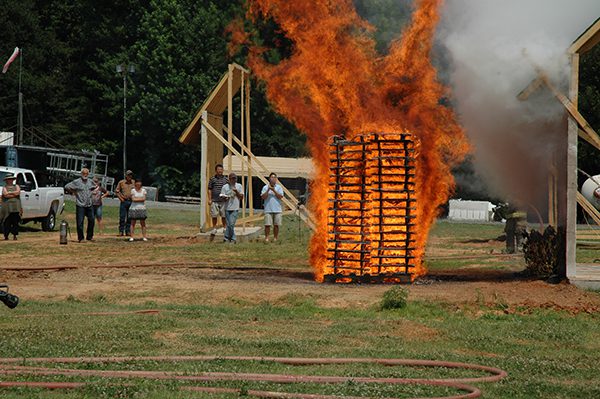
The program also began doing collaborative research with the Charlotte Fire Department. CFD was very generous in building a laboratory space for the UNC Charlotte researchers’ equipment at a facility off Shopton Road in Charlotte.
“There was nowhere on campus to do research for fire,” Kimble said, “and that was for multiple reasons. One, we were limited for space, and two, the university was not amenable at all to us generating a big smoke plume on campus.”
When the ET Department began freshman and sophomore classes in 2004, the Fire ET faculty had 10 to 11 more courses to teach, including Introduction to Engineering Technology 1202. They also began to see the demographics of their students changing.
“I think the most interesting part of that whole thing was when the transition was taking place we still had old salt veteran firefighters in class along with 18 and 19 year olds, and it was mutually beneficial,” Kimble said. “The older guys could set a good example, but the younger guys raised the bar academically, because they had just come out of high school pre-cal and chemistry and physics. It wasn’t like one group was exceedingly better than the other. They were different and it was very interesting to see that group dynamic, especially when they did group projects. The real winner out of that, I think ultimately, was a lot of those younger students, because they got to sit in class with a lot of guys who were in influential positions in the fire department and they got jobs.”
Research in the Fire Safety ET program began to grow further in 2007 with the addition of faculty members Jozef Urbas and Aixi Zhou. At same time, the group began to plan a master’s degree program, to again meet the demands of professionals in the state. Fire departments were beginning to require graduate degrees for executive-level competency positions and there were no such programs in North Carolina.
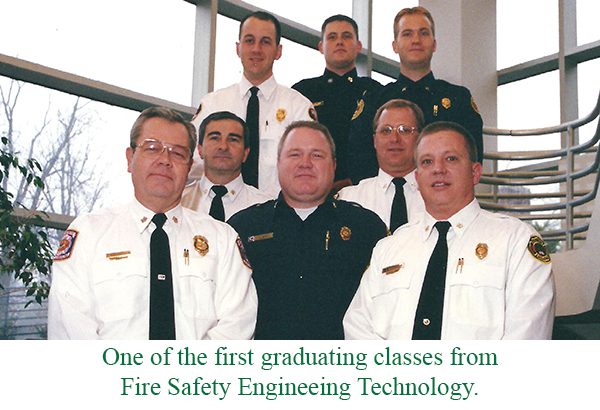
In 2012, the Master of Fire Protection and Administration began with four students. By 2015, the number of students was up to 11. All students in the program shared a common core of 12 credits, and could then specialize in classes, projects and theses in either fire protection or fire administration.
During his 16 years at UNC Charlotte, Kimble said he was always been able to look with pride on the fire program graduates. “Members of our advisory council consistently told us our students were well educated and able to communicate. They told me that in interviews and promotion assessment panels they could always tell who our students were, because of these soft skills. So, we did something right in our 16 years here. Our students were getting hired in more and more places.”
The opportunity to start a program from scratch and watch it grow was rewarding, Kimble said. “I don’t think I could have ever gone anywhere else and been able to develop a program where I could say ‘Hey, that has my fingerprints on it.’ We developed it with input from the state and we actually developed what they were looking for. We were here to serve a need and we succeeded.”